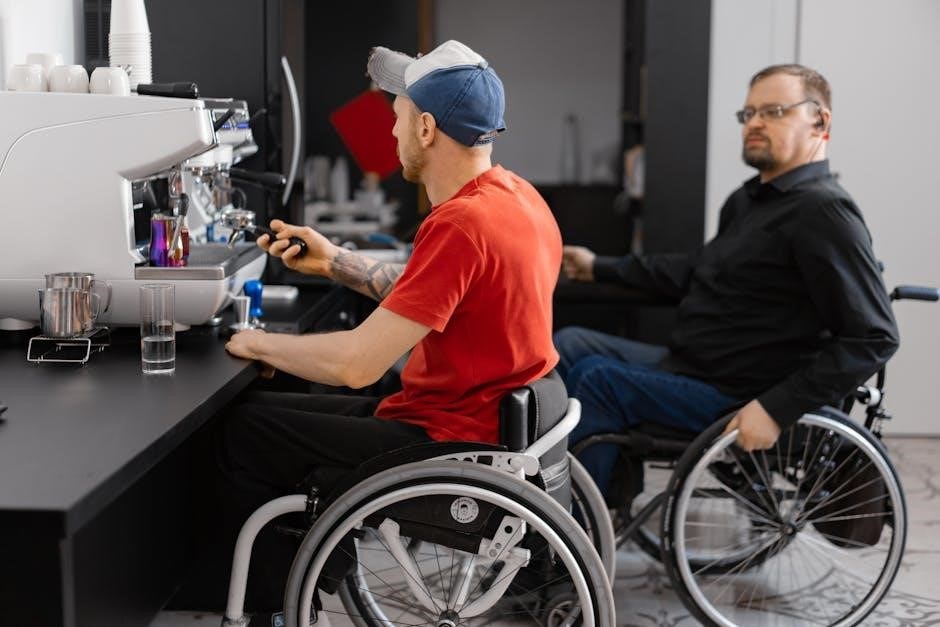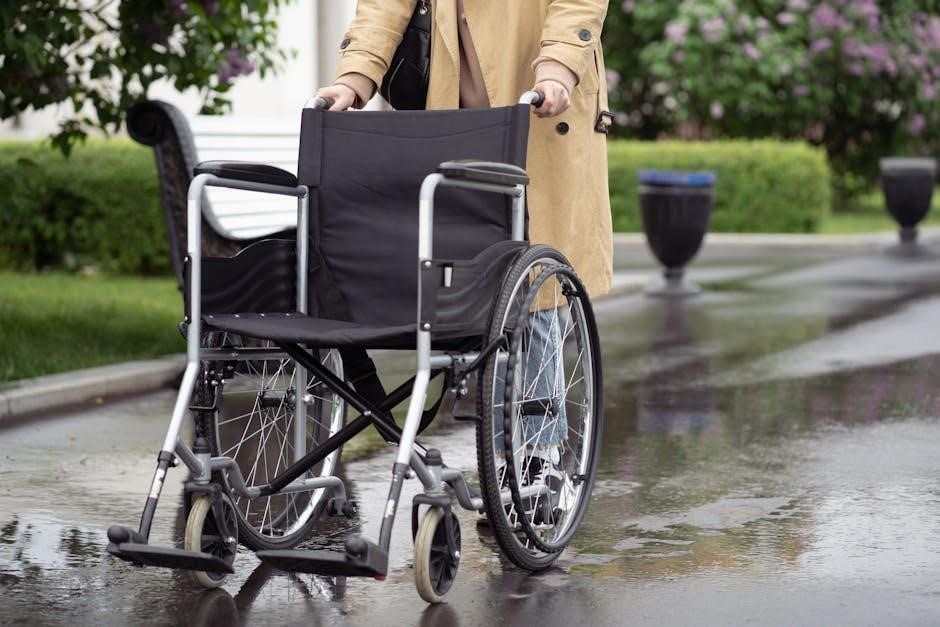manual handling for disability support workers

Manual handling for disability support workers involves safely lifting, pushing, or pulling to assist clients. Proper techniques and training are crucial to prevent injuries and ensure client well-being and independence.
Definition and Scope of Manual Handling
Manual handling refers to any activity requiring the use of force to lift, lower, push, pull, carry, move, hold, or restrain objects or people. In disability support, it involves assisting clients with mobility, transfers, or daily tasks. The scope includes tasks like transferring clients from beds to wheelchairs, supporting walking, or lifting clients safely. Proper techniques are essential to minimize risk of injury to both workers and clients. Training focuses on assessing individual needs, using assistive devices, and maintaining client dignity. Effective manual handling ensures client well-being while adhering to legal and safety standards.
Importance of Safe Manual Handling Practices
Safe manual handling practices are crucial to prevent injuries to both disability support workers and clients. Proper techniques reduce the risk of strain, sprains, and long-term musculoskeletal disorders. For clients, safe handling ensures dignity, comfort, and prevents harm. Adhering to safe practices also promotes legal compliance and meets workplace safety standards. Additionally, it fosters a culture of care and respect, enhancing client trust and well-being. Employers benefit from reduced workplace injuries, lower absenteeism, and improved productivity. Prioritizing safe manual handling creates a safer, more supportive environment for everyone involved.
Challenges in Manual Handling for Disability Support
Manual handling in disability support presents unique challenges, including the diverse and complex needs of clients. Workers must adapt techniques to accommodate varying mobility, weight, and medical conditions, requiring precise judgment and skill. Limited access to assistive devices or equipment in some settings can increase the physical strain on workers. Additionally, the emotional and psychological demands of supporting clients with complex disabilities can complicate manual handling tasks. Ensuring client dignity while maintaining safety is a constant challenge. Continuous training and access to resources are essential to overcome these obstacles and provide effective, compassionate support. Addressing these challenges is vital for both worker well-being and client safety.

Legal and Policy Frameworks
Legal and policy frameworks govern manual handling practices, ensuring compliance with safety standards and disability support regulations. These frameworks emphasize employer responsibilities and mandatory training requirements to protect workers and clients.

Occupational Health and Safety Regulations
Occupational Health and Safety (OHS) regulations are critical in governing manual handling practices for disability support workers. These regulations mandate safe work practices, employer responsibilities, and employee training to minimize risks. Laws such as the Work Health and Safety Act require employers to provide a safe working environment, including proper manual handling techniques. Employers must conduct risk assessments and implement controls to reduce injuries. Workers are entitled to training and equipment to perform tasks safely. Non-compliance can result in legal penalties, emphasizing the importance of adherence. These regulations ensure that both workers and clients receive adequate protection, promoting a safer and more supportive care environment.
Disability Support Workforce Standards
Disability support workforce standards outline the skills, knowledge, and competencies required for workers to provide high-quality care. These standards emphasize safe manual handling practices, ensuring workers are trained to minimize risks. Mandatory training is often a key component, focusing on lifting techniques, hazard identification, and client-centered care. Workers must demonstrate competence in applying these standards to real-world scenarios. The standards also promote continuous improvement, encouraging workers to stay updated on best practices. By adhering to these standards, disability support workers can deliver care that respects client autonomy and dignity while maintaining a safe working environment. These standards are essential for fostering a culture of safety and excellence in disability support services.
Employer Responsibilities and Compliance
Employers in disability support services must ensure safe manual handling practices by providing mandatory training and conducting regular risk assessments. They are responsible for maintaining a safe work environment, including proper equipment and resources. Employers must comply with occupational health and safety regulations, ensuring all staff understand their roles in manual handling. This includes reporting incidents and near misses to prevent future accidents. Employers are also obligated to stay informed about legal requirements and industry standards, adapting policies as needed. Compliance with these responsibilities ensures both worker and client safety, fostering a culture of accountability and care; Regular audits and updates to safety protocols are essential for sustained compliance.

Manual Handling Training and Education
Manual handling training equips disability support workers with essential skills to safely lift, move, and support clients, reducing injury risks and promoting client well-being through practical techniques.
Core Components of Manual Handling Training
Core components of manual handling training include understanding the principles of safe lifting, hazard identification, and the use of assistive devices. Training emphasizes proper bodily mechanics, client-centered approaches, and legal compliance. Practical exercises and case studies are integral, focusing on tasks specific to disability support, such as transferring clients or using equipment. Workers learn to assess individual client needs, adapt techniques, and maintain client dignity. Training also covers emergency response and incident reporting, ensuring a comprehensive skill set for safe and effective manual handling in various care settings. Regular updates and refreshers are recommended to keep skills current and aligned with best practices.
Practical Techniques for Safe Lifting and Moving
Practical techniques for safe lifting and moving involve bending at the knees, keeping the back straight, and holding the load close to the body. Workers should avoid twisting and ensure proper grip and balance. Using assistive devices, such as hoists or slide sheets, can significantly reduce strain. Communication with the client is crucial to understand their needs and preferences. Techniques must be adapted to the individual’s abilities and circumstances, prioritizing their comfort and safety. Proper positioning and pacing are also essential to prevent fatigue and injury. These methods ensure that manual handling is performed effectively while respecting the client’s dignity and promoting their independence.
Online Resources for Manual Handling Training
Online resources for manual handling training provide accessible and flexible learning opportunities for disability support workers. These resources include e-learning modules, video tutorials, and interactive guides that cover safe lifting techniques, hazard identification, and the use of assistive devices. Many platforms offer certification upon completion, ensuring workers meet industry standards. For example, the National Disability Services (NDS) offers collaborative training modules specifically designed for disability support. Additionally, free online courses are available, focusing on practical skills and client-centered care. These resources are updated regularly to reflect best practices and legal requirements, making them invaluable for continuous professional development and improving workplace safety.

Risk Assessment and Hazard Identification
Risk assessment and hazard identification are critical in manual handling to evaluate tasks, identify potential risks, and implement control measures, ensuring a safer environment for both workers and clients.
Identifying Hazardous Manual Tasks
Identifying hazardous manual tasks is essential to minimize risks in disability support work. These tasks often involve lifting, pushing, pulling, or carrying, which can strain muscles or cause injuries. Key factors include the weight of the load, awkward postures, and repetitive movements. Assessing the environment and client’s mobility also helps pinpoint potential hazards. For instance, transferring a client with limited mobility may require specific techniques to avoid injury. Understanding these risks allows workers to implement safer practices and use assistive devices effectively. Regular risk assessments and task analyses are vital to ensure the well-being of both workers and clients. Early identification of hazards promotes a safer and more supportive care environment.
Conducting a Risk Assessment for Manual Handling
Conducting a risk assessment for manual handling is crucial to identify and mitigate potential hazards. This process involves evaluating the task, environment, and individual capabilities. Observing how workers perform manual handling tasks helps pinpoint unsafe practices. Assessing the client’s mobility, weight, and medical conditions is also essential. Environmental factors, such as space constraints or uneven surfaces, should be considered. The assessment should document potential risks and recommend strategies to reduce them, like using assistive devices or adjusting techniques. Regular reviews ensure ongoing safety and adapt to changing client needs or workplace conditions. A thorough risk assessment promotes a safer environment for both workers and clients, minimizing injury risks and enhancing care quality. Proper documentation and communication of findings are vital for effective implementation of safety measures.
Creating a Risk Management Plan
Creating a risk management plan for manual handling involves systematically identifying, assessing, and controlling risks to ensure a safe working environment. The plan should outline specific strategies to eliminate or minimize hazards, such as using assistive devices, adjusting work practices, or providing additional training. It should also include monitoring procedures to ensure compliance and effectiveness. Documentation is key, with clear steps for implementation, review, and updates. The plan must be tailored to the specific needs of the workplace and clients, ensuring that all stakeholders are informed and involved. Regular reviews and updates ensure the plan remains relevant and effective in reducing manual handling risks. This proactive approach helps protect both workers and clients from injury.

Safe Manual Handling Techniques
Safe manual handling techniques involve maintaining proper posture, using assistive devices, and applying client-centered approaches to minimize strain and prevent injuries during lifting and moving tasks.
General Principles of Safe Lifting
Safe lifting begins with bending at the knees, keeping the back straight, and using leg muscles to lift. Maintain a firm grip on the load and keep it close to the body. Balance is crucial—avoid twisting or reaching. Smooth, controlled movements reduce strain. Assess the load’s weight and size beforehand. Prioritize client-centered care, ensuring dignity and comfort. Use assistive devices when necessary to minimize manual effort. Proper footwear and workspace organization also support safe lifting practices. These principles aim to protect both the worker and the client from injury, promoting a safe and respectful care environment.
Specific Techniques for Supporting People with Disabilities
When supporting people with disabilities, tailored techniques are essential. Use slide sheets or transfer belts to facilitate smooth movements, minimizing strain and discomfort. For clients with mobility challenges, pivot transfers or standing transfers may be appropriate. Always communicate clearly, encouraging the client to assist as much as possible. Maintain a stable base and use leg strength to support the client’s weight. Avoid lifting directly from the floor; instead, bend at the knees and lift from a crouched position. Ensure the client’s body is properly aligned and supported throughout the process. Personalized plans should be developed based on the individual’s abilities and needs, respecting their autonomy and promoting independence. Proper training and equipment are vital to ensure safety and dignity for both the client and the support worker.
Using Assistive Devices and Equipment
Assistive devices and equipment are crucial in manual handling for disability support workers. Tools like slide sheets, transfer belts, and hoists reduce physical strain and enhance safety. Electric hoists allow for smooth, controlled transfers, while standing aids assist clients in moving independently. Wheelchairs and adjustable beds are also essential for safe repositioning. Proper use of these devices requires training to ensure effectiveness and client comfort. Regular maintenance and inspection of equipment are necessary to prevent malfunctions. By utilizing appropriate assistive technology, support workers can promote client dignity, independence, and well-being while minimizing the risk of injury to both parties. Effective use of such tools is a cornerstone of modern disability care.

Manual Handling and Client Well-being
Manual handling plays a vital role in promoting the well-being of clients with disabilities. Safe techniques ensure dignity, prevent injuries, and respect autonomy, fostering independence and quality of life.
Client-Centered Care in Manual Handling
Client-centered care in manual handling prioritizes the individual’s needs, preferences, and comfort, ensuring dignity and autonomy. Support workers collaborate with clients to create personalized plans, fostering trust and confidence. Clear communication and active listening are essential to understand each client’s unique requirements. This approach respects the client’s right to make decisions about their care, promoting independence and self-esteem. By focusing on the client’s physical and emotional well-being, manual handling becomes a respectful and empowering experience, reducing feelings of dependency or embarrassment; Client-centered care also ensures that support workers adapt their techniques to meet diverse needs, enhancing overall safety and satisfaction.
Respecting Client Autonomy and Dignity
Respecting client autonomy and dignity is fundamental in manual handling for disability support workers. Clients should be encouraged to make informed decisions about their care, ensuring their preferences and boundaries are honored. Support workers must prioritize open communication, actively listening to clients’ needs and concerns. Maintaining privacy and confidentiality is essential, as is avoiding actions that may cause embarrassment or discomfort. Involving clients in planning and decision-making fosters trust and mutual respect. This approach acknowledges the client’s right to control their own life, even when physical assistance is required. Respecting autonomy and dignity not only upholds the client’s self-worth but also strengthens the support worker-client relationship, creating a more positive and empowering care environment.
Preventing Client Injury During Manual Handling
Preventing client injury during manual handling is a top priority for disability support workers. Proper lifting techniques, such as bending at the knees and maintaining a neutral spine, can significantly reduce the risk of harm. Assessing the client’s weight and mobility beforehand ensures a safe approach. Using assistive devices like hoists or slings can minimize strain and prevent accidents. Regular training and updates on best practices are essential for staying informed. Encouraging client participation in their care, such as using their strength to assist, can also aid in preventing injuries. A thorough risk assessment and personalized care plan are vital to safeguarding both the client and the worker during manual handling tasks, ensuring safety and well-being for all involved.

Manual Handling Emergencies and Incident Response
Manual handling emergencies require quick thinking and proper training to ensure client and worker safety. Assessing the situation, prioritizing well-being, and knowing when to seek professional help is crucial.
Handling Emergency Situations in Manual Handling
In emergency situations, disability support workers must act quickly and safely. If a client loses balance or collapses, prioritize their safety by gently guiding them to a stable position. Use assistive devices or seek immediate assistance to prevent injuries. Stay calm and assess the situation to avoid exacerbating the issue. Always follow established protocols and communicate clearly with the client and team members. If a client is injured, provide first aid and document the incident for further review. Regular training ensures preparedness for such scenarios, minimizing risks and ensuring the well-being of both clients and workers.
Reporting Incidents and Near Misses
Timely and accurate reporting of incidents and near misses is essential in manual handling for disability support workers. All incidents, including injuries to clients or workers, must be documented and reported to supervisors immediately. This ensures proper medical attention and legal compliance. Near misses, though not resulting in harm, should also be reported to identify and mitigate potential risks. Incident reports help organizations analyze patterns, improve safety protocols, and prevent future accidents. Employers are legally required to maintain records of incidents, which also aids in workers’ compensation claims and continuous improvement of manual handling practices. Transparency and accountability are key to fostering a safe work environment.
Post-Incident Care and Support
Post-incident care and support are critical following a manual handling incident involving a disability support worker or client. Immediate medical attention must be sought for any injuries, with thorough documentation of the incident. Workers may require time off to recover, supported by employer-provided resources. Clients involved in incidents should receive reassurance and ongoing care to maintain their trust and well-being. Employers must also offer counseling services to address any psychological impacts. Additionally, incidents trigger reviews of safety procedures to prevent recurrence. Open communication between all parties ensures a supportive environment, fostering recovery and resilience. This comprehensive approach upholds both worker and client safety and well-being.

Industry Standards and Best Practices
Industry standards for manual handling emphasize adherence to safety guidelines, regular training, and use of assistive devices to minimize risks and enhance client care quality effectively.
International Guidelines for Manual Handling
International guidelines for manual handling emphasize evidence-based practices to minimize risks for both workers and clients. The World Health Organization (WHO) advocates for improved access to assistive technologies, as highlighted in resolution 71.8, to enhance safety and independence. These guidelines stress the importance of risk assessments, proper training, and the use of ergonomic equipment; They also promote client-centered care, ensuring dignity and autonomy during manual handling tasks. Regular updates to these guidelines reflect advancements in technology and best practices, aiming to reduce injuries and improve outcomes in disability support settings globally. Adherence to these standards is crucial for creating a safer, more efficient care environment.
Best Practices in Disability Support Work
Best practices in disability support work prioritize client-centered care, ensuring dignity, autonomy, and safety. Support workers should use practical manual handling techniques tailored to individual needs, respecting clients’ preferences and abilities. Regular risk assessments and the use of assistive devices can significantly reduce the risk of injury. Clear communication and active involvement of clients in their care promote empowerment and independence. Additionally, ongoing training and adherence to international guidelines, such as those from the World Health Organization, are essential for maintaining high standards. By focusing on person-centered approaches, disability support workers can provide effective, compassionate, and safe care, enhancing overall well-being and quality of life for clients.
Continuous Improvement in Manual Handling
Continuous improvement in manual handling involves regularly reviewing and enhancing practices to ensure safety and efficiency. Encouraging feedback from clients and staff helps identify areas for improvement. Staying updated with the latest techniques and technologies, such as assistive devices, is crucial. Organisations should implement a culture of learning, where training is ongoing and adaptive to new challenges. By fostering collaboration and sharing best practices, disability support workers can refine their skills and adapt to evolving client needs. This proactive approach not only reduces the risk of injuries but also enhances the quality of care provided, ensuring better outcomes for both clients and support workers.

Technology and Innovation in Manual Handling
Technology and innovation revolutionize manual handling by introducing robotic aids, sensor-equipped devices, and advanced assistive equipment, enhancing safety, efficiency, and client mobility in disability support settings.
Assistive Technology for Manual Handling
Assistive technology plays a vital role in enhancing manual handling practices for disability support workers. Devices like hoisting systems, transfer equipment, and adjustable beds enable safe and efficient client transfers. Wearable exoskeletons and sensor-equipped tools further reduce physical strain on workers. These technologies not only improve mobility and independence for clients but also minimize the risk of injuries. Organizations worldwide, including the WHO, emphasize the importance of access to such technologies. By integrating innovative solutions, disability support workers can provide higher quality care while maintaining safety standards. Proper training on these devices ensures their effective use, benefiting both clients and caregivers alike in achieving optimal outcomes.
Innovative Solutions for Disability Support
Innovative solutions are transforming manual handling practices in disability support, enhancing safety and efficiency. Advances like AI-powered wearable devices and smart wheelchairs improve mobility and reduce physical strain. Customizable assistive tools, such as adaptive seating and robotic aids, cater to individual client needs. Telehealth platforms also enable remote monitoring and support, ensuring continuous care. Collaboration between engineers, healthcare professionals, and disability advocates drives the development of these solutions. By integrating technology with person-centered approaches, these innovations empower clients to maintain independence while safeguarding workers from injuries. The future of disability support lies in leveraging such cutting-edge solutions to create inclusive, accessible, and sustainable care environments for all.
The Future of Manual Handling in Disability Care
The future of manual handling in disability care is poised for significant advancements, driven by technology and a focus on client-centered approaches. Emerging technologies like AI, robotics, and wearable devices will enhance safety and efficiency, reducing physical strain on workers. Personalized assistive devices and smart equipment will enable greater independence for clients. Telehealth and remote monitoring systems will also play a larger role in providing timely support. Training programs will increasingly incorporate virtual reality and simulation tools to prepare workers for diverse scenarios. The integration of these innovations aims to create a safer, more inclusive, and sustainable care environment, prioritizing both client well-being and worker safety.
Leave a Reply
You must be logged in to post a comment.